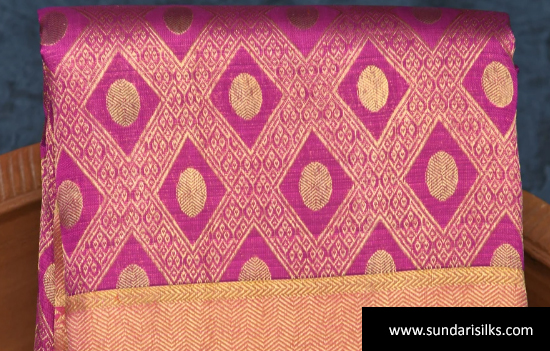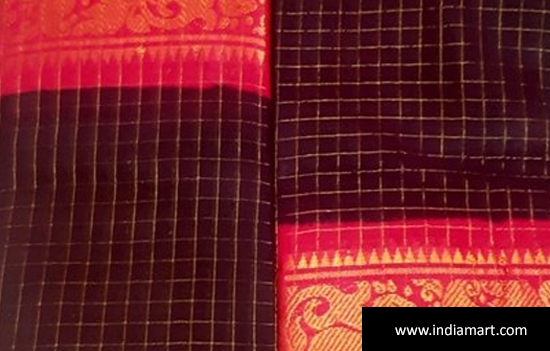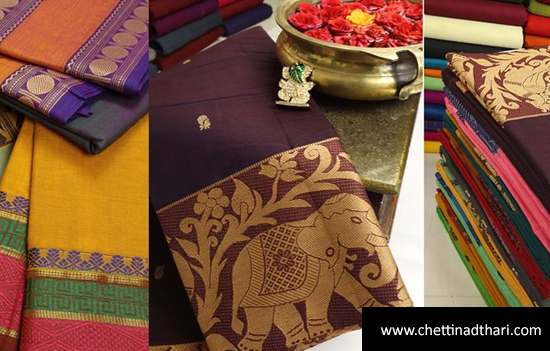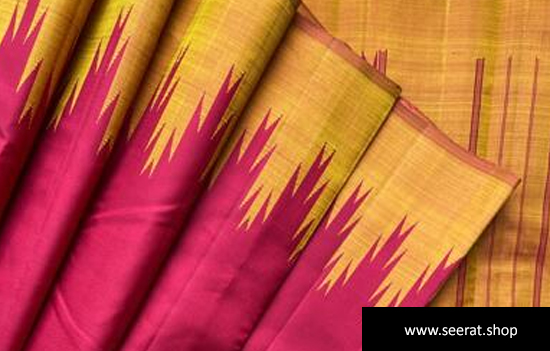- Know about handloom sarees of Tamil Nadu namely Kanjeevaram Silk,
Madurai Sungudi, Chettinad and Arani Silk.
Tamilians
have perfected the art of spinning, weaving and chiselling over the years and
their brilliance is reflected in different art subjects like bronzes, sculptor
works, carvings, etc.
Magnificent temples represent Tamil architecture with lofty ‘gopurams’ and statues of goddesses engraved all over the edifice.
To
see pictures of Meenakshi
Temple Madurai, Brihadesvara
Temple Tanjore and Shore
Temple Mahabalipuram
Let
us explore the textiles of Tamil Nadu. This covers Kanjeevaram Silk Sarees,
Madurai Sungudi, Chettinad Sarees and Arani Silk.
Kanjeevaram Silk Saree

Borrowing its name from the village of its origin, Kanchipuram aka Kanjeevaram is a silk saree that can be compared to Kashi’s Banarasi saree. Owing to the thick fabric and deep colours mixed with hints of gold, this saree is preferred for festive occasions and celebrations. Like with most silk sarees, you can count on Kanjeevaram sarees to be the perfect choice when you are looking for a classy Indian option.
Origin and history
The
story of the Kanjeevaram silk saree begins in Hindu tradition. It is believed
that Kanchi silk weavers are descendants of Sage Markanda, who was considered
to be the master weaver for the Gods themselves.
Settled
in the small town of Kanchipuram (Tamil Nadu), the famous Kanjeevaram saree
weave goes back 400 years. It was during the reign of Krishna Devaraya
(Vijayanagara Empire) that the art really took off. Two major weaving
communities of Andhra Pradesh, the Devangas and Saligars migrated to the town
of Kanchipuram. They used their excellent weaving skills to make the silk saree
have images of scriptures and figurines that were found on the temples.
It
did not take long for the saree to evolve into a must-wear for women at
ceremonies, weddings and other festivities, a practice that still continues in
South India.
Weaving process
Kanchipuram
silk sarees are woven from pure mulberry silk. While the silk belongs to South
India, the pure gold and silver zari comes from Gujarat. The silk thread that
is used to weave the saree is dipped in rice water and sun-dried before it is
used in order to increase both, its thickness and stiffness. The silk thread is
then interlocked with a thin silver wire and woven through after which a golden
thread is used to complete the procedure.
The
warp frame use to weave this fabric has about 60 holes, in which there are 240
threads in the warp and 250 to 3000 threads in the weft, giving it a sturdy
feel. The pallu, the border and the body of the saree are generally woven
separately, and then interlocked together with much precision and neatness.

Special features
Since
the colour and designs of the body and the pallu are quite different, weavers
weave both of them separately and eventually join them. You can spot a zig zag
pattern (known as the pitni)
where the body meets the pallu. It is also quite a common practice to weave the
border of the saree separately and then join the three together. The joining of
the three (known as korvai) is
done with such precision that even if the saree tears, the border will not
detach.
Also
since the zari is made of three silk threads twisted with a silver wire, the
fabric is extremely strong and durable. This, however, can also add to the weight,
making a regular Kanjeevaram Saree as heavy as two kilos.
Colours
The sarees are known for their vibrant colours and eye-catching designs, which
are mainly inspired from the scriptures and figurines from the very many
temples in the village. Since the pallu
and the body of the saree differ in colour and design, you can expect a variety
of contrasting shades too.
Motifs
Ever
since its inception, Kanchipuram silk sarees have stayed true to the inclusion
of temple figurines and traditional stories into the design.
The
border of the saree comprises of motifs from the temples, palaces and general
paintings, and the body includes pyramidal temple designs, checks, stripes and
floral buttas.
Over
the years, the traditional and much preferred stripes or golden dot designs
have given way to more symbolic motifs such as fruits, animals, birds, the sun
and the moon etc.
Varieties
Kanchipuram silk sarees were initially a nine-yard weave but over the
years the more practical six-yard weave was included. The original golden and
silver zari is now replaced by a cost-effective metal or copper zari that
manages to hold on to the sheen of the texture while reducing the cost.
However, if you want an original you need to ensure that the zari work is genuine.
Current state of the art
Kanchipuram
sarees have been recognized as a Geographical Indication by the government in 2006.
This can be considered as a mark of authenticity and has helped improve the
sales of Kanjeevaram silk sarees. As of now there are about 5,000 families
involved in the production and there are 15 silk and cotton yard industries and
60 dyeing units in the region to aid the production process.
Price range
An
original saree with pure silk and pure zari can cost anywhere between Rs.7000 to
Rs 2 lakh. To cut down on cost you get budgeted versions like the pure silk
plus imitation zari or the half silk-half synthetic plus imitation zari saree,
which manage to hold on to the sheen of the original, but lose out on the
durability of the fabric. These sarees cost a lot less and can be bought at a
price of Rs.2-5,000.
How to identify a Kanchipuram silk saree
One
of the most telling signs is that the border of the saree and the body will be
in total contrast. However, you do have cheaper versions in the market, which
follow the same design rules but make use of artificial zari. You need to look
closely at the colour of the finished zari work to identify a fake.
One
of the most fool proof ways to tell the difference between an original and fake
Kanchipuram silk saree is to pick a few loose threads from the saree, burn
them, pick the remaining ash and smell it. It smells similar to that of burnt
leather or hair. The ones made using artificial fibers will have no ash upon
burning.
Another
easier and more doable test would be to look for the loose ends of zari in the
saree. Pure zari is made of red silk thread i.e. then twisted with a silver
thread and dipped in gold. If you find the zari thread white or any other
colour, you can be certain that this is a fake.
Also
look for the Silk Mark that is given
to pure Kanchipuram silk sarees.
Care guide
Dry
cleaning is the most preferred method to maintain the saree. However, if you do
have to wash the saree at home avoid using soap during the first three washes.
A rinse in cold water is more than enough. It is advisable to store the saree
separately in a plastic or saree bag.
Credits
Here
and Here
2. The Magnificence of Madurai Sungudi

The ringing of temple bells, the scent of jasmine, jigarthanda and the magnificent sungudi sarees is what makes Tamil Nadu’s Thoonganagaram a beautiful city. Every weave has a tale to tell, making each saree a masterpiece that brings the weaver sheer pleasure. The sungudi craft has an interesting journey from Central and Western India to the city of Madurai.
Around
500 years ago, Saurashtrian weavers migrated from Gujarat and settled in
Madurai when the Nayak Dynasty was ruling. These weavers were highly skilled
artisans. Their women specialised in tying and the men in dyeing. Once they
settled in Madurai, they decided to bring their rich tie-dye
heritage a new meaning by adding a local touch to their craft. The pattu-nool-karars incorporated the tie and dye craft in creating Madurai’s signature textile, the sungudi sarees.
Even
today you can witness washed and bleached white fabrics fluttering on the banks
of River Vaigai. A story goes by saying that the women of Madurai were the
inspiration for Sungudi sarees. Elated by how the women in Madurai tied their
hair into a bun, the weavers created round patterns on the fabric which
resembled a bun. They took tiny pinches of the cloth and tied it with threads.
After that, the fabric was immersed in containers of natural dyes. When the
fabric was opened out, the tied-up areas kept their base colour, while the rest
of the fabric took in the dye.
The
dotted pattern that resulted looked like stars scattered across the night sky.
Hence a few believe that the sungudi designs were inspired by celestial
constellations that led to the creation of those circular motifs. The classic
elegance of the dotted designs and restrained beauty of surface ornamentation
created by the sungudi craft is revealed as each knot is untied. It combines an
ancient technique with contemporary designs and styles.
The
pattu-nool-karar named this masterpiece of a weave as Sungudi, derived
from the Sanskrit word sunnam meaning “round”. These sarees were worn by queens in the pre-colonial period and were honoured in the kingdoms of Tamil Nadu. Its ancient royal lineage has been translated into fashionable and elegant designs for today’s youth and socialites.
The
essence of a perfect sungudi saree is grace, beauty, and ease, which merges the
art of elegance in itself. The sungudi sarees usually come in an array of
vibrant and subtle colours like crimson, olive, yellow and blue. A traditional
sungudi saree does not have the same colour throughout; the borders and
end-pieces are usually a different colour than the main body of the saree. A
zari pattern with complementary warp threads is often used in the borders.
Modern
sungudi sarees include a variety of patterns and motifs, such as flowers and
peacocks, and thus bear little resemblance to the authentic sungudi sarees
which have kolam and constellation patterns.
Every
year February 8 is celebrated as Sungudi Day to honour their unique heritage
and magnificent work of craftsmanship. The art is passed down over the
generations. Madurai is not only known for sungudi, but also for weaving, and
thus meets a large demand for sungudi sarees even today. Unravelling each
sungudi textile provides a glimpse into Tamil culture. As a result, Sungudi
craft is a legacy of ancient handcrafting skills and a cultural signifier.
Read
a good
blog, cotton
sarees blog, Credits
3. Chettinad Cotton Saree

Chettinad sarees are basically made of cotton. This particular type of saree is admired for creating an illusion with the extensive use of colour and pattern with bold checks, stripes and contrasting tints. The Chettinad saree is also known as "Kandaangi". Its vibrancy and weight are unique. The sarees are a prized possession of every South Indian lady. Such kind of sarees can be worn on all occasions due to their simplicity and traditional look.
Chettinad sarees are created in such a way that it becomes heavy and weighty.
Although, these very sarees offer an ethnic look, the thickness of these sarees
have made them rare item of saree for nearly 100 years. Records and old
photographs show the use of saree by previous generations, before the advent of
blouses and underskirts, which is worn rather differently from the regular
saree. These sarees were woven in different vibrant hues and the artisans
used silk and cotton as fabrics.
Etymology of Chettinad Saree
The
name of Chettinad saree was derived from the place where it was created. Chettinad is
a town in Tamil Nadu (76 kms from Madurai). It is more known for palatial
Chettinad homes and tiles.
Chettinad Saree Designs and Styles
The
Chettinad sarees are designed by incorporating checks of vivid colours. The
traditional Chettinad sarees are found in mustard, brick red and black colours.
Both cotton and silk are used in the making of
these sarees. The use of both silk and cotton threads have given rise to
a new-look in these sarees, creating a sort of modern design with a traditional
approach.
The main style of south Chettinad sarees is the inclusion of checks and stripes
of varied colours. There are huge contrast borders in appealing colour
combinations in these sarees. The contrast colour borders together with the
horizontal and vertical stripes give a very striking look and adding the zest
of the fabric.
The width of the traditional Chettinad sarees is only 91cm as compared to the normal sarees with width of 120cm. Thus, when draped, this type of saree reaches only till the calves which provide a graceful flaunt of the wearer's anklets. However, today, the Chettinad sarees are woven to the regular width of 120 cm.
Development of Chettinad Saree Industry
Chettinad
cotton sarees are woven out of 100% pure cotton fabrics. The handloom industry
in Tamil Nadu is promoting and encouraging weavers of Chettinad who specialise
in weaving handloom cotton and silk cotton Chettinad sarees. These cotton
sarees of Chettinad have become more popular because colour never fades. The
colour remains the same even after many washes because of the unique threading
length and quality adopted by the weavers.
Demand for Chettinad Sarees
With time, the styles and patterns of these sarees have undergone tremendous change. There is no doubt that the Chettinad saree adds charm and delicacy to the wearer's personality if draped in the right way.
Chettinad
Sarees are today considered a glamorous wear for most Indian ladies. The sarees
are available in varied colours and thus are one of the most sought after
traditional sarees in the Indian market. Slowly these sarees have also entered
the foreign market.
The saree is regaining traction due to special efforts of some entrepreneurs. Today, silk and cotton fabrics are mixed to
create a fusion of design and material. Artisans and designers are working to
give modern and contemporary designs, a designer look. All efforts being made
to revive the past glory.
Site
has different
types of Chettinad Sarees and Credits, read Blog
4. Arani Silk

Arani
is a small town located in the district of Thiruvannamalai in the state of
Tamil Nadu. It is approximately 132 km from Chennai and is one of the most
important silk centers of Tamil Nadu. Along with many other silks that are
manufactured in Tamil Nadu, the Arani silk saris are the carriers of the
historic Saurashtrian legacy.
The
displaced artisans after moving from one location to another due to changing
monarchies finally settled in the southern region. Due to their competence they
soon became master weavers. While they preserved their roots, their integration
with the Tamil community is also deep and the confluence of both distinct
styles is richly displayed in Arani saris.
The
handlooms of Arani are famous for their softness and durability. The fabric is
soft and comfortable to wear and is suitable for all Indian climates. The looms
used here are mostly frame looms that are fixed in a frame with the pedal at
floor level. The weaver sits on a low stool and uses both hands and legs to
weave.
The
very first step is the processing of the yarn that is washed and dipped in the
required colour. This is done in a boiler with the worker constantly turning
the yarn so that the colour gets evenly mixed. Here the most important part is
the mixing of the dyes that will give a unique and durable shade to the fabric.
After drying and washing, these yarns are starched which further seals in the
colour that gives the yarn a polished and finished look. This yarn is bought by
master weavers and then converted into thread using a charkha and this thread
is used as the weft.
The
prepared yarn is then loaded onto looms. The length of the yarn loaded as a
warp is called Pavyu. A weaver can
make four saris from one Pavyu and it will take approximately one week to weave
one pavyu of four saris.
The
count used in weaving saris gives us the softness or hardness of the fabric. That
is the number of threads woven lengthwise and breadth wise, also known as warp
and weft. For e.g. if the count in a sari is 2400, that means there will be
2400 threads in weft and warp.
In
order to create a unique design, nowdays first a soft copy of the same is made
in a computer which prints it out on thick cards that are then loaded into the
Jacard, a box like structure at the top of the loom that has needles that will
follow the holes in the card and duplicate the design in the sari while weaving
it simultaneously. Due to demand dress materials are also created along with
saris.
The
most unique and distinguishing aspect of Arani saris is that it is made with two different bodices on either side and
even two different pallus. This allows the wearer to use it as two
different saris. The saris are very shrewdly constructed with an interlocking
border-the korvai. On one side, half the length of the sari will be in one color and the other half in another color and at the two ends of the sari you will have pallus of different colors, and the entire length on the other side will be of a completely different color with a different pallu. This sari can be worn as three different saris! Garments don’t get any more versatile than this.
Traditionally
Arani silk saris were bright, colorful and rich. They still maintain their
addiction to bright colors, gold zari and typical motifs. The silks are
embellished with checked patterns called kottadis
along with stripes. The weavers in this profession are torch bearers of the
ancient trade. They proudly proclaim that none of them is formally trained in
this art but have gathered their unique skills from their ancestors through the
method of vision and practice.
The
beautiful weave has also been granted GI status by the Government of India.
There is a story which says that the first flag hoisted on Independence Day at
the Red Fort was a silk flag woven at Arani.
Credits
here
or here
The
purpose of this compilation is to document and promote. We have given credits
and reference links in this compilation along with third party links (to
promote). In case some are missed, it is not with malafide intent. Please
email full details to esamskriti108@gmail.com
and we shall effect the change.
To read all
articles by author
To
read all articles on Traditional Indian Textiles of India
Author Trishna
Patnaik
is a self-taught artist based in Mumbai, Trishna has been practising art for over 14 years. She is now a full-time professional painter pursuing her passion to create and explore to the fullest. She conducts painting workshops across India. She is also an art therapist and healer who works with clients on a one to one basis. Not to forget her quality writings on Indian Art and now Textiles for esamskriti. She fancies the art of creative writing.